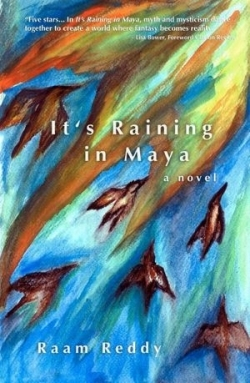It's Raining in Maya
There is magic everywhere.
This is not just a child’s notion but a central theme in Raam Reddy’s novel It’s Raining in Maya. Lush language twirls around descriptions of the green necklace of forest that surrounds the fictional town of Maya. The curiosity, hope, and innocence of the young protagonist, Aditi, is described with skill. Part coming-of-age story and part poem, It’s Raining in Maya chronicles the tale of a girl moving between the world of her imagination and the reality around her. This book will appeal to readers fond of the lyricism and lessons in such books as The House on Mango Street.
Aditi’s well-defined curiosity is highlighted in the opening anecdote before the novel truly begins. She watches a madman saluting a tree and asking it to send gifts to worthy souls, and yellow trash to those who are not. Here, she notes the beautiful change “from the usual axes hacking away.” Similarly, on a fishing trip with her Uncle, Aditi describes the disappointment of watching other boats fill the area when all along she believed that the sea was her own. But when she spots the seagulls, she sees that they are like her brothers and sisters. The happiness of this thought is undercut by the mention of a brother who was born “sleeping.”
The joy of It’s Raining in Maya is in its restraint. Reddy does not unfold the plot or the story all at once. A dark undercurrent is introduced with Aditi’s father, a man whose job is mixing paints and who becomes disoriented and confused because of it. He cannot bear to find another line of work because, as is said again and again, “it’s all he knows.” When he hears that his daughter has been drawn into a world of art and crayons, he enters her bedroom and lights a flame with the intention of burning her work. For a moment destruction hangs in the air, but then he relents and simply kisses his daughter’s forehead. Later in the novel, he begs and screams that he “deserves another life,” but then repeats his earlier declaration that he “mixes paint.” This conflict bubbles beneath the surface, continually threatening to burst up. The notion that a parent’s past can haunt a child’s future will speak to readers young and old.
Metaphor is everywhere: Aditi’s descent begins when she cannot “find the sky,” meaning her blue crayon. The resulting manic-like drawing is filled instead with black as she wonders “how to fill the emptiness.” Such fine scenes speak volumes. Every detail adds to this colorful picture—the town and the people who are resolved to stay in it, Aditi’s innocence and light in the face of a storm, and the deep-running conflicts throughout.
This is a story in which people believe the lake was formed by the tears of a “heavy cloud that fell in love with a star.” In It’s Raining in Maya, myth and mysticism dance together to create a world where fantasy becomes reality.
Reviewed by
Lisa Bower
Disclosure: This article is not an endorsement, but a review. The publisher of this book provided free copies of the book and paid a small fee to have their book reviewed by a professional reviewer. Foreword Reviews and Clarion Reviews make no guarantee that the publisher will receive a positive review. Foreword Magazine, Inc. is disclosing this in accordance with the Federal Trade Commission’s 16 CFR, Part 255.

